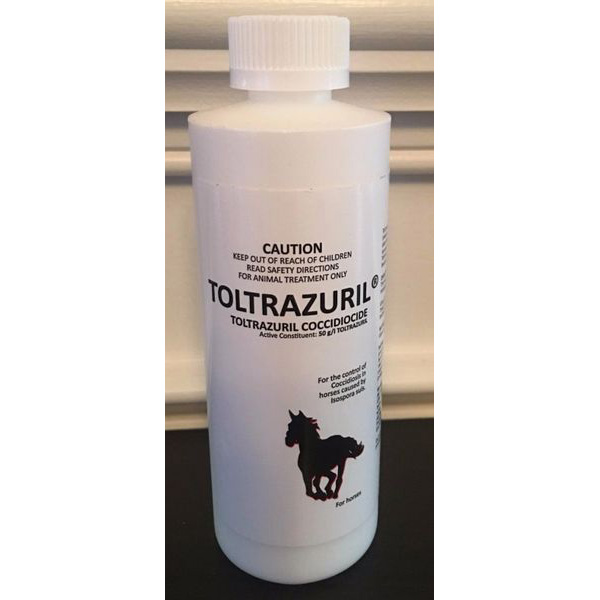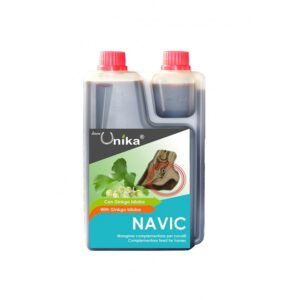Description
Toltrazuril is the result of extensive research efforts to help treat EPM (equine protozoal myeloencephalitis), which causes a multitude of effects that manifest in a variety of symptoms. Our solution represents a new standard in coccidiosis control, belonging to the chemical group of symmetric triazinons not related to any other anticoccidial drug currently in use in veterinary medicine. Our 2.5% solution affects all intracellular structures of the one-celled protozoan parasite called Sarcocystis neurona. Toltrazuril is highly effective and has demonstrated the following benefits:
-prevents and reduces the severity of lesions
-stops oocyst shedding
-improves growth rate
-improves feed conversion
HOW IT WORKS:
Our Toltrazuril 2.5% solution is suitable for both therapy and metaphylaxis, and acts as an effective tool for controlling coccidia-related problems. By damaging the intracellular developmental stages of Coccidia, toltraturazil affects schizonts, microgametes, and macrogametes without damaging the cell tissue of the host animal. Findings from studies suggest the drug interferes with the division of the nucleus and the activity of mitochondria, which is responsible for respiratory metabolism in the parasite. In the magrometes, toltrazuril damages wall-forming bodies, and in all intracellular developmental stages, severe vacuolisation occurs due to inflation of the endoplasmatic reticulum. Toltrazuril does not interfere with immune development, and usually does not require follow-up treatment, even in advanced infections (after three to five days). However, the efficacy of the drug is independent from the severity of the infection.
Toltrazuril is quite lipid soluble so absorption and distribution into tissue is very good. Toltrazuril 2.5% has a unique mode of action and there is no reason to be concerned with an adverse reaction or a drug-drug reaction. As Toltrazuril only has activity against protozoa, there is no effect on upset of intestinal flora and the formulation is very well tolerated. To be soluble in water, the product undiluted is very alkaline, pH 11.4. Direct oral dosing of the undiluted product is very irritating to mucous membranes and will cause immediate vomiting. Make sure you are using the correct formulation.
Toltrazuril is a relatively new treatment that may actually cure coccidiosis, instead of just suppressing it. The drug is readily available in Canada and Australia, but not the US. While other drugs have been used to control Coccidia infections, they do not provide a cure, and the animal may continue to be infectious to other animals.
FOR USE WITH CATS:
DO NOT use the 2.5% solution sold as a pigeon remedy, as it can be caustic to the mucus membranes of cats.
DO NOT use this drug in pregnant cats as the teratogenic effects of this drug has not been adequately researched as of now.
Dosage: SHAKE WELL. Oral administration of 0.4ml per pound. Examples: 1000 lb. horse – 400ml. 10 lb. dog – 4ml. Preferred treatment is every four days for seven doses, then once per month thereafter OR upon advice from your veterinarian. However, it is recommended to repeat the treatment weekly for a couple of weeks. It is CRITICAL to clean the environment to rid it of coccidia. This drug is most effective when it is used at the age of 4-6 weeks to PREVENT coccidia infection in kittens.
Toltrazuril is designed to dose cats before the presence of clinical signs. Most catteries have issues with coccidiosis in young kittens around 5 weeks of age, meaning treatment should be given around day 28 so as to kill the early stages of the protozoa. The treatment will not cause sloughing of the intestinal epithelial cells. The coccidiosis does a fine job of that on its own. Intestinal cells remain intact and functional while the single cell stages of the cocci are dead, as evidenced by staining techniques in studies. As Toltrazuril is cidal, kittens do not have to depend on their immune systems to eliminate the cocci as they would with a drug that only treats symptoms.
It is very difficult to judge when a kitten is infected, which is why administration prior to clinical symptoms is recommended. The intent is to kill the protozoa before there is damage to the villi to clear the infection. In this way, the kittens will not develop the normal clinical signs of diarrhea. If you can identify oocysts in fecal exam, the protozoa has completed its reproductive cycle. The drug can not penetrate the oocyst wall to kill this stage, but treatment at the first signs of a clinical case will still help to limit the severity and duration of the infection as the Toltrazuril will kill single cell stages that have not reproduced sexually yet.







Reviews
There are no reviews yet.